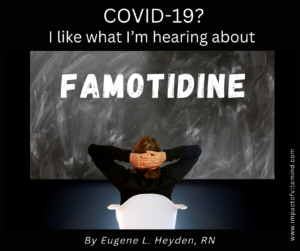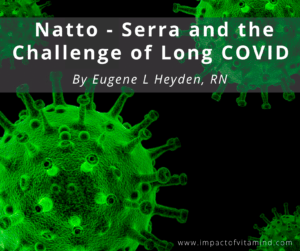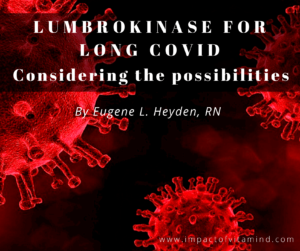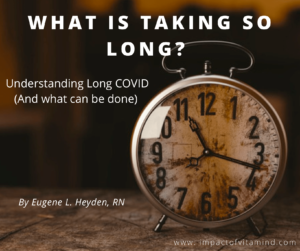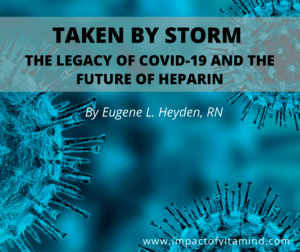Psychological Problems After COVID-19: A Case Report
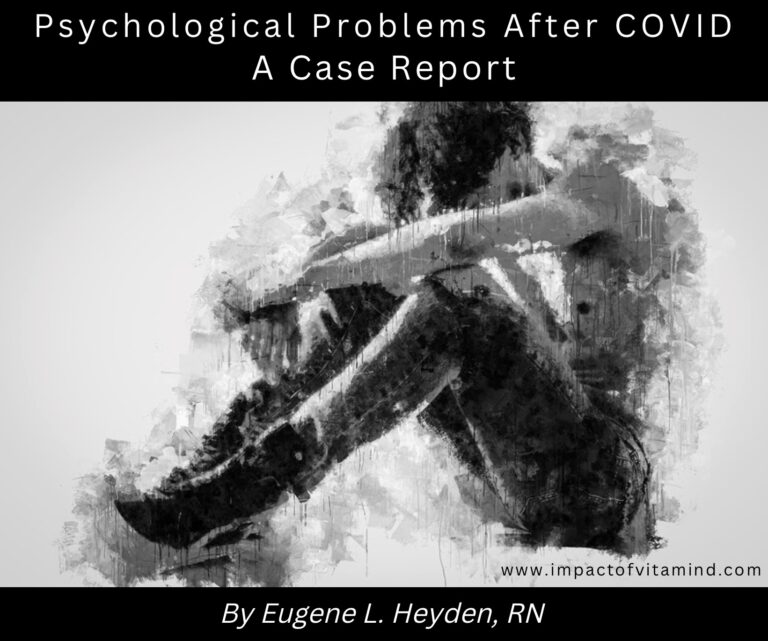
By Eugene L. Heyden, RN
“Neuroinflammation plays an increasingly appreciated role in psychiatric disorders. SARS-CoV-2 is neuroinvasive and neuroinflammatory. ~Alper, 2020, emphasis added
“We report that both viral RNA and/or Spike protein remain in circulation long after acute infection (more than one-year post-infection in some cases) and this persistent circulation of viral components is associated with PASC [AKA Long COVID].” ~Craddock et al., 2022
“Emerging evidence suggests mast cell activation or a dysfunctional response play a role in COVID-19 via the release of multiple pro-inflammatory cytokines and prothrombotic mediators, especially since mast cells are stimulated by viruses. The result is inflammation around brain blood vessels that may generate a vicious cycle or autoimmune loop of neuroimmune processes casing L-COVID [Long COVID].” ~Theoharides and Conti, 2021, emphasis added)
I’ve heard great things about famotidine. I’ve heard it can reduce both the disease severity and the death rate in COVID-19 (Freedburg et al., 2020; Janowitz et al., 2020). I’ve also heard it can help relieve the symptoms of Long COVID-19 (Alper, 2020; Glynne at al., 2022). If all this is new to you, then perhaps you should keep reading.
The symptoms of Long COVID are often neurological symptoms—brain fog, fatigue, confusion, depression, and the list could go on and on. Now why would that be? The infection is over, or so we are told. But there is a problem that remains. The body parts of the virus, particularly the spike protein, are still around (raddock et al., 2022; Kell et al., 2022l Swank et al., 2022). Indeed, the detection of spike protein has been identified as long as 15 months post infection, found within a circulating immune cell called the monocyte (Kell et al., 2022) They must be picking them up from somewhere! And likely, the persistence of spike protein provokes a continual stimulation of immune cells, including a particular cell positioned within the brain called the mast cell (Lam et al., 2021; Theoharides and Conti, 2022). Important to our conversation, upon stimulation, one of the pro-inflammatory chemicals released by the mast cell is histamine (Lam et al., 2021), making the mast cell and histamine management therapeutic targets in Long COVID. Indeed, the symptoms of Long COVID closely resemble another condition called Mast Cell Activation Syndrome (MCAS) (Lam et al., 2021; Theoharides, 2022; Batiha et al., 2022), strongly suggesting that what is good for MCAS is also good for Long COVID.
Clearly identified, is the persistence of spike protein long after the acute COVID-19 illness subsides (Craddock et al., 2022; Kell et al., 2022l Swank et al., 2022). That is, after the battle against the virus has ended (following the acute infection), a highly immunostimulatory part of virus, the spike protein, is left behind, and in great numbers—circulating, challenging, and capable of evoking pro-inflammatory responses, even in the brain (Theoharides et al., 2021). If there is one thing we know for certain, neuroinflammation can wreak havoc with brain function (Skaper et al., 2017). So just possibly, if we can reduce neuroinflammation, we can make some headway (carefully chosen word) in the battle against Long COVID.
One thing to place under consideration, is our bodies response to viral invasion. As it turns out, the SARS-CoV-2 virus spike protein evokes aberrant clotting–an effort to wall off and isolate the virus, even a portion of the virus (spike protein), with the platelet playing a central role (Kell et al., 2022). Another interesting thing the body does, is to flood the zone with chemical mediators. And apparently, the mast cell does a very good job of this. Obviously, it has something purposeful in mind. But, although well-meaning, not every response is a good thing, and the mast cell can overrespond and be a driver of a variety of neuroinflammatory symptoms (Theoharides, 2022). Blocking or stabilizing the receptors designed to respond histamine, limiting histamine’s ability to drive inflammatory responses, has been shown to reduce inflammation, particularly in the brain. Let’s see how this all plays out in the following case report.
Case report: Robert
Robert (a pseudonym) is an 18-year-old individual who contracted COVID in February of 2020. Apparently, before his illness, he was in good health, both mentally and physically, and without a history of drug abuse or a history of psychiatric issues. Instead of taking Robert’s life, COVID was satisfied with taking away the person Robert used to be.
Robert’s brush with death (contracting COVID-19) was really not all that much to brag about—a week of fatigue and 3 weeks of coughing, considered to be seasonal allergies or simply just a cold. Not bad for contracting a deadly disease. Because COVID-19 was new on the scene, initial COVID testing was not performed, but after suspicions were raised Robert tested positive for the SARS-CoV-2 antibody.
After 3 weeks of relatively mild illness, Robert returned to life as usual. But that was short-lived. Approximately 3 weeks after recovering from COVID, the fatigue returned. And this time, it was accompanied by psychological and behavioral changes, enough so, Robert sought professional help. Symptoms included anxiety, sadness, depression, lack of motivation and inability to concentrate, as well as “disruptive behavioral episodes with increased emotional reactivity.” Unsurprisingly, Robert received the diagnosis of Bipolar II Disorder, and the initial professional interaction and follow-up therapy sessions were regarded as unhelpful. Life was not at all how it should be. And, sleeping was not at all as it should be. So, we find Robert taking melatonin to help him fall and stay asleep. Aside from that, no meds were taken, or other therapy initiated, following his initial diagnosis of Bipolar II Disorder.
Unimproved, and with doubts about the correctness of diagnosis and direction of therapy, Robert sought a second opinion. Good call!
At 19 weeks post-COVID, the second opinion would pay off. Someone put two and two together and operated on the assumption that Robert was experiencing neuropsychiatric issues as an expression of Long COVID. And that certain someone knew just what to do. As a physician, he had heard great things about famotidine (PEPCID®)—its ability to reduce neuroinflammation by limiting the ability of histamine to signal to evoke the production of pro-inflammatory factors such as cytokines—and suspected it could help Robert turn things around. And a prescription for famotidine was written. So, how did it go?
“Famotidine 20 mg twice daily administered orally was begun without any additional medications. At 1-week follow-up the patient was much improved. Improvement was sustained through 12 weeks of follow-up during which the patient continued to take famotidine without apparent side effects.” (Alper, 2020)
It looks like Robert got his life back, at least well on his way to becoming his normal self again. And it only took about 4 days for remarkable improvement to be achieved.
“On follow-up a week later, the patient said he felt ‘much better’ and noted substantial improvement regarding his symptoms of heightened emotional reactivity and diminished motivation and sustained attention. He estimated the time interval between starting famotidine and symptomatic improvement at 4 days and described his state on the fourth day as ‘clear-headed,’ ‘. . . I woke up and got out of bed without feeling awful. . . .'” (Alper, 2020)
Related Posts
References
Alper K. Case report: Famotidine for neuropsychiatric symptoms in COVID-19. Frontiers in Medicine. 2020:936. https://www.frontiersin.org/articles/10.3389/fmed.2020.614393/full?fbclid=IwAR2xINK_xugxFV6tFR2OkDXgrNkWuAgQ_4BH-s5HeqrCKh1EhRYQdOQ86ck
Batiha GE, Al-Kuraishy HM, Al-Gareeb AI, Welson NN. Pathophysiology of Post-COVID syndromes: a new perspective. Virology Journal. 2022 Dec;19(1):1-20. https://link.springer.com/article/10.1186/s12985-022-01891-2
Craddock V, Mahajan A, Krishnamachary B, Spikes L, Chalise P, Dhillon N. Persistent Circulation of Soluble/EV-Linked Spike Protein and Viral RNA in Individuals with Post-Acute Sequelae of COVID-19. EV-Linked Spike Protein and Viral RNA in Individuals with Post-Acute Sequelae of COVID-19. 2022 https://papers.ssrn.com/sol3/papers.cfm?abstract_id=4186787
Freedberg DE, Conigliaro J, Wang TC, Tracey KJ, Callahan MV, Abrams JA, Sobieszczyk ME, Markowitz DD, Gupta A, O’Donnell MR, Li J. Famotidine use is associated with improved clinical outcomes in hospitalized COVID-19 patients: a propensity score matched retrospective cohort study. Gastroenterology. 2020 Sep 1;159(3):1129-31. https://www.gastrojournal.org/article/S0016-5085(20)34706-5/abstract
Glynne P, Tahmasebi N, Gant V, Gupta R. Long COVID following mild SARS-CoV-2 infection: characteristic T cell alterations and response to antihistamines. Journal of Investigative Medicine. 2022 Jan 1;70(1):61-7. https://jim.bmj.com/content/70/1/61?fbclid=IwAR2dD2aSIkUN%5C_Bc8OUvcK%5C_Zt0YI48Z8g2%5C_39s8gZo7i2SkH3JicUPFkSjsE
Janowitz T, Gablenz E, Pattinson D, Wang TC, Conigliaro J, Tracey K, Tuveson D. Famotidine use and quantitative symptom tracking for COVID-19 in non-hospitalised patients: a case series. Gut. 2020 Sep 1;69(9):1592-7. https://gut.bmj.com/content/69/9/1592.abstract
Kell DB, Laubscher GJ, Pretorius E. A central role for amyloid fibrin microclots in long COVID/PASC: origins and therapeutic implications. Biochemical Journal. 2022 Feb 17;479(4):537-59. https://portlandpress.com/biochemj/article-abstract/479/4/537/230829
Lam HY, Tergaonkar V, Kumar AP, Ahn KS. Mast cells: Therapeutic targets for COVID‐19 and beyond. IUBMB life. 2021 Nov;73(11):1278-92. https://iubmb.onlinelibrary.wiley.com/doi/abs/10.1002/iub.2552
Skaper SD, Facci L, Zusso M, Giusti P. Neuroinflammation, mast cells, and glia: dangerous liaisons. The Neuroscientist. 2017 Oct;23(5):478-98. https://journals.sagepub.com/doi/abs/10.1177/1073858416687249
Swank Z, Senussi Y, Alter G, Walt DR. Persistent circulating SARS-CoV-2 spike is associated with post-acute COVID-19 sequelae. Medrxiv. 2022 Jan 1. https://www.medrxiv.org/content/10.1101/2022.06.14.22276401.abstract
Theoharides TC, Conti P. Be aware of SARS-CoV-2 spike protein: There is more than meets the eye. J Biol Regul Homeost Agents. 2021 May 1;35(3):833-8. http://www.mastcellmaster.com/documents/2021-08/SARS-CoV-2-Spike-protein_J-Biol-Reg-Homeost-Agents-2021.pdf
Theoharides TC, Cholevas C, Polyzoidis K, Politis A. Long‐COVID syndrome‐associated brain fog and chemofog: Luteolin to the rescue. Biofactors. 2021 Mar;47(2):232-41. https://iubmb.onlinelibrary.wiley.com/doi/abs/10.1002/biof.1726
Theoharides TC. Could SARS-CoV-2 spike protein be responsible for long-COVID syndrome?. Molecular Neurobiology. 2022 Mar;59(3):1850-61. https://link.springer.com/article/10.1007/s12035-021-02696-0
DISCLAIMER: This article is offered solely for informational purposes. The information contained therein and opinions expressed should be evaluated for accuracy and validity in the context of opposing data, new information, and the views and recommendations of a qualified health care professional, and not to be substituted for professional judgment and guidance or to provide a reason to neglect or delay appropriate medical care for self or for others. It is the reader and reader only who bears the responsibility for any actions that could be construed as being a response to the information presented. The statements and opinions expressed by the author have not been reviewed or approved by the FDA or by any other authoritative body, nor is the author endorsing any product or specific therapy mentioned. This article and the opinions contained therein are offered to the reader to broaden his or her understanding of the issues discussed and to help identify options that may be suitable for the individual to pursue, on behalf of self or others, under approval and direction of a qualified physician or medical team member. All questions of a medical nature which arise from reading this article should be directed at qualified health care professional. There are no guarantees that a suggested website and internal links are safe to visit or open or are currently available.
Copyright © 2022 Eugene L. Heyden, RN
All Rights Reserved.

